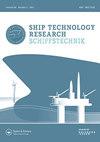Numerical methods for seakeeping problems
IF 0.9
Q3 ENGINEERING, MARINE
引用次数: 0
Abstract
It is my pleasure to present you a review of the recently published book of Springer Nature on ‘Numerical Methods for Seakeeping Problems’. The three co-authors of the book are internationally renowned experts in the development of numerical methods/software tools and their use in solving practical problems of seakeeping of ships and floating structures. The material of the book is to a large extent based on lectures held at the Technical University Hamburg-Harburg and the University of Duisburg-Essen, as well as on cited publications of the authors. Even more, all three authors have many years of experience with the service work of a major classification society (Germanischer Lloyd), when they supported the needs of the international maritime industry. Whereas in the past the knowledge of ship’s seakeeping was considered of prime importance only for special types of ships (e.g. naval ships), when compared to ship’s calm water performance and stability, it is not so nowadays in view of enhanced requirements for ship’s operation in realistic sea conditions and the safety of ships, of people onboard and cargo related to ship’s dynamic (intact and damage) stability. Even more, the recently introduced international regulations for the reduction of Green House Gas emissions, affecting both ship’s design and operation, call for methods and tools to assess ship’s performance in realistic sea conditions. The gained knowledge from the longstanding development of efficient numerical methods and software tools, along with their practical use, are presented in this book by a renowned team of experts and will be briefly commented in the following. The book consists of 17 chapters. After a brief introduction into the subject of the book in chapter 1, while considering marine accidents that were affected by adverse weather conditions, the theory of seakeeping is gradually introduced by first presenting the governing fundamental equations of fluid flow (incompressible viscous and ideal fluids) and the rigid body motions (nonlinear and linearized equations of motion) in chapter 2. In chapter 3, fundamental numerical methods for the incompressible potential flows (with and without lift) are presented, along with a demonstration software tool for the two-dimensional flow around a smooth body without lift. In chapter 4 the basic theory of regular and irregular water waves is introduced, while considering the linear superposition principle and spectral analysis techniques for the simulation of linear and nonlinear natural seaways and their ensuing statistics of important parameters. In chapter 5, quasi two-dimensional strip theory seakeeping methods are elaborated, starting with a brief history of developments after the fundamental work of F. Ursell in 1949. Strip theory methods became very popular over the years due to their low computational effort and the wide dissemination of the ensuing theory and numerical implementation. The linear and nonlinear computation of added mass, hydrodynamic damping and of the wave exciting forces on 2D sectional forms is herein presented, as well as the determination of the ship motions and wave induced forces in regular waves by a strip theory method originally developed by H. Söding (code PDStrip). Finally, the effect of hull interaction of multi-hull vessels on the radiated and diffracted waves is discussed. In chapter 6, an efficient three-dimensional Green Function/Panel seakeeping method is presented, and discussed, in which the forward speed effect is accounted for in a simplified way by exploiting basic assumptions of slender body theory. Examples of application by use of the code GL Panel are presented and discussed (T. E. Schellin). In chapter 7, a linear three-dimensional Rankine source method is presented, and discussed. It is first applied to the steady flow problem of a ship with forward speed (wave resistance problem) and then extended to the unsteady, time harmonic flow problem of a ship moving with forward speed in a regular wave train. Special attention is paid to the numerical treatment of the free surface boundary condition and of a transom stern, if applicable. Results of the implemented method are presented in a series of publications of H. Söding and his associates. In chapter 8, a new, fully nonlinear Rankine source method developed by H. Söding is presented, and typical results of its application in comparison with model experiments and RANS methods are discussed. The method allows the computation of large (nonlinear) ship motions and of wave-induced loads, as encountered in severe sea conditions. In difference to the previously presented frequency-domain methods, this is a timedomain method simulating the ensuing physical problem in the time-domain, while accounting for nonlinearities of the above still waterplane hull form and of the ensuing kinematic body and free surface boundary conditions. In chapter 9, viscous flow field methods are presented and discussed. After a brief introduction and presentation of the Reynolds-Averaged Navier Stokes (RANS) Equations, the basic field flow methods are introduced, namely Large Eddy Simulation (LES) and Hybrid Model methods. Issues of grid generation, including耐波性问题的数值方法
我很高兴向大家介绍最近出版的b施普林格Nature关于“保浪问题的数值方法”的书。本书的三位合著者是国际知名的数值方法/软件工具的发展专家,他们在解决船舶和浮式结构的耐波性实际问题上的应用。这本书的材料在很大程度上是基于在汉堡-哈堡工业大学和杜伊斯堡-埃森大学举行的讲座,以及作者引用的出版物。更重要的是,所有三位作者都有多年在大型船级社(德国劳埃德船级社)服务工作的经验,当时他们支持国际海运业的需求。在过去,船舶的耐浪性知识被认为只对特殊类型的船舶(例如海军舰艇)至关重要,而与船舶的静水性能和稳定性相比,现在由于对船舶在实际海况下的操作以及船舶、船上人员和货物的安全要求的提高,与船舶的动态(完好和损坏)稳定性有关。此外,最近出台的减少温室气体排放的国际法规对船舶的设计和操作都有影响,要求在实际海况下评估船舶性能的方法和工具。从有效的数值方法和软件工具的长期发展中获得的知识,以及它们的实际应用,由一个著名的专家团队在本书中提出,并将在以下简要评论。这本书共有17章。在第1章简要介绍了本书的主题之后,考虑到受恶劣天气条件影响的海上事故,通过在第2章中首先提出流体流动(不可压缩粘性流体和理想流体)和刚体运动(非线性和线性化运动方程)的控制基本方程,逐渐介绍了耐波性理论。在第三章中,给出了不可压缩势流(有升力和没有升力)的基本数值方法,以及一个无升力光滑体周围二维流动的演示软件工具。第四章介绍了规则和不规则水波的基本理论,同时考虑了线性叠加原理和谱分析技术对线性和非线性自然航道的模拟及其重要参数的统计。第五章阐述了准二维条形理论的耐波性方法,并简要介绍了自1949年乌塞尔(F. Ursell)的基础性工作以来的发展历史。条形理论方法由于其较低的计算量和随后的理论和数值实现的广泛传播,近年来变得非常流行。本文介绍了附加质量、水动力阻尼和波浪激励力在二维截面上的线性和非线性计算,以及用H. Söding(代码PDStrip)最初开发的条形理论方法确定规则波中的船舶运动和波浪诱导力。最后讨论了多船体船体相互作用对辐射波和绕射波的影响。第六章提出并讨论了一种高效的三维格林函数/面板保浪方法,该方法利用细长体理论的基本假设,以简化的方式考虑了正向速度效应。应用的例子,使用代码GL面板提出和讨论(T. E.谢林)。第七章给出了一种线性三维朗肯源方法,并对其进行了讨论。该方法首先应用于正航速船舶的定常流动问题(波阻问题),然后推广到正航速船舶的非定常时谐流动问题。特别注意的是自由表面边界条件的数值处理,以及如果适用的话,对尾梁的数值处理。所实现方法的结果发表在H. Söding和他的同事的一系列出版物中。第八章提出了一种全新的全非线性朗肯源方法,并与模型实验和RANS方法进行了比较。该方法允许计算大型(非线性)船舶运动和波浪引起的载荷,如在恶劣的海况下遇到。与之前提出的频域方法不同,这是一种时域方法,在时域中模拟随后的物理问题,同时考虑到上述静止水平面船体形式以及随后的运动体和自由表面边界条件的非线性。第九章给出并讨论了粘性流场方法。 在简要介绍了reynolds - average Navier Stokes (RANS)方程的基础上,介绍了基本的场流方法,即大涡模拟(LES)和混合模型方法。网格生成的问题,包括
本文章由计算机程序翻译,如有差异,请以英文原文为准。
求助全文
约1分钟内获得全文
求助全文

 求助内容:
求助内容: 应助结果提醒方式:
应助结果提醒方式:


